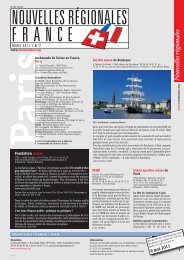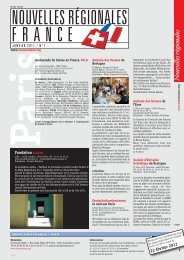Which energy will be best for Switzerland? Doris ... - Schweizer Revue
Which energy will be best for Switzerland? Doris ... - Schweizer Revue
Which energy will be best for Switzerland? Doris ... - Schweizer Revue
Create successful ePaper yourself
Turn your PDF publications into a flip-book with our unique Google optimized e-Paper software.
11<br />
06<br />
What should <strong>be</strong> done<br />
with the radioactive<br />
waste produced by <strong>Switzerland</strong>’s<br />
five nuclear power<br />
plants? And what is the ethical<br />
justification <strong>for</strong> storing nuclear<br />
waste <strong>for</strong> tens of<br />
thousands of years?<br />
Rechsteiner: Nuclear power plants represent an unacceptable safety risk and must <strong>be</strong> prevented with all the<br />
political and legal means at our disposal. On closer inspection, the so-called “nuclear renaissance” is pure propaganda.<br />
Few nuclear power plants are <strong>be</strong>ing built anywhere in the world, and even these are mostly at the state’s<br />
expense. In view of the trend towards renewable energies, especially wind and solar power, it is <strong>be</strong>coming increasingly<br />
difficult to justify new nuclear risks even <strong>for</strong> propaganda purposes. Atomic <strong>energy</strong> is not only <strong>be</strong>set<br />
by unsolved safety and waste problems. Its competitiveness on the free market is also restricted by a lack<br />
of cost-effectiveness and long construction times. Wind farms the size of the Gösgen plant can <strong>be</strong> planned<br />
and built within a year. Nuclear power plants, by contrast, take ten times as long.<br />
Steinmann: From an ethical point of view, it’s clear that we must solve the problem of radioactive waste disposal,<br />
<strong>be</strong>cause as the <strong>be</strong>neficiaries of atomic <strong>energy</strong> we owe it to future generations to clean up our mess. Extreme<br />
care must <strong>be</strong> taken in selecting possible locations <strong>for</strong> storage. This we are doing by putting together a<br />
“deep geological depository plan” which starts by laying down the criteria by which we should select suitable<br />
locations. Aside from safety criteria – the safety of people and the environment are always <strong>for</strong>emost –<br />
there are also pressing social and economic criteria and needs to take into account. Only when all the criteria<br />
are in place can the actual search <strong>for</strong> a storage location <strong>be</strong>gin, with cantons, responsible <strong>for</strong>eign bodies,<br />
organisations and the general public <strong>be</strong>ing in<strong>for</strong>med early on and involved in the process as appropriate. Assuming<br />
the Swiss authorities give us carte blanche, possible locations can then <strong>be</strong> assessed on the basis of<br />
these criteria. Further geological analyses may also need to <strong>be</strong> carried out. The procedure <strong>for</strong> selecting a location<br />
could <strong>be</strong> completed by the end of the decade. The aim is to <strong>be</strong> able to start using the deep depository<br />
by around 2040.<br />
Spreng: The problem should not <strong>be</strong> played down, and when it comes to storage, corners should not <strong>be</strong> cut.<br />
In <strong>Switzerland</strong> we are well on the way towards developing a concept that both offers reliable passive protection<br />
in stable geological strata and – <strong>for</strong> future generations – provides <strong>for</strong> checks with the possibility of improving<br />
storage. Other sectors could take a leaf out of this book.<br />
Could wind farms in<br />
07 the North Sea one<br />
day replace our nuclear power<br />
plants <strong>for</strong> generating electricity?<br />
How do you evaluate<br />
wind <strong>energy</strong> from a technical<br />
point of view i.e. in terms of<br />
power fluctuations, line loss,<br />
landscape conservation and<br />
wind availability?<br />
Rechsteiner: There is no technical solution to the waste problem. All we have is damage limitation. Even<br />
burial deep underground entails risks that merit a worldwide ban on nuclear technology. It’s just a question of<br />
time.<br />
Steinmann: First we have to ask ourselves what exactly we mean by “securing supply <strong>for</strong> our country”. Can<br />
nuclear power stations in France, gas-fired plants operated by Swiss companies in Italy, or wind parks run by<br />
majority Swiss-owned Nordic firms make a real contribution towards securing our <strong>energy</strong> supplies in the sense<br />
of <strong>be</strong>ing self-sufficient? It’s also debatable whether there’s really any sense in transporting <strong>energy</strong>. Firstly, transporting<br />
electricity over such large distances involves not insubstantial losses. Secondly, present-day transport<br />
capacities would hardly suffice, which means that we’d need massive investment in new lines. For landscape conservation<br />
reasons and <strong>be</strong>cause of the relatively low wind factor, only a few locations in <strong>Switzerland</strong> are suitable<br />
<strong>for</strong> wind <strong>energy</strong> generation. In the EU, by contrast, wind <strong>energy</strong> is witnessing a huge expansion, partly also in<br />
the face of stiff opposition from environmental groups. If the proportion of wind <strong>energy</strong> in the European electricity<br />
network increases, this can lead to fluctuations in production and prices. And this in turn could <strong>be</strong>nefit<br />
Swiss storage power stations, which could provide back-up power at very short notice when the wind drops.<br />
Spreng: Wind farms are a good thing. And, in principle, wind and water complement each other nicely in<br />
terms of electricity production. But we Swiss are not alone in Europe. The countries that build these wind<br />
farms <strong>will</strong> want to use this electricity themselves and build the necessary back-up power plants and network<br />
support facilities. As regards landscape conservation, there is no way of generating <strong>energy</strong> without a downside.<br />
SWISS REVIEW August 2006 / No. 4<br />
Rechsteiner: Wind <strong>energy</strong> is increasingly <strong>be</strong>ing harvested in all the world’s oceans. Its potential has even<br />
<strong>be</strong>en recognised in China and the United States. When DC lines are used, transport losses remain <strong>be</strong>low 5<br />
percent, even over very long distances (1000-2000 km). Fluctuations in wind availability can always <strong>be</strong> managed<br />
if wind farms are properly networked. After all, it’s always windy somewhere. Added to this, we have electricity<br />
storers and demand-side management. Landscape conservation regulations restrict planning and ensure<br />
that large wind farms are built in sparsely populated areas or out at sea. However, just like hydroelectric<br />
plants in the Alps, wind farms are very lucrative <strong>for</strong> local residents. That’s why wind power exploitation is<br />
growing exponentially.
















